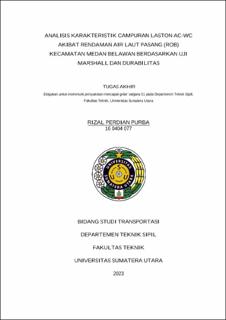Analisis Karakteristik Campuran Laston AC-WC Akibat Rendaman Air Laut Pasang (ROB) Kecamatan Medan Belawan Berdasarkan Uji Marshall dan Durabilitas
Characteristic Analysis of Asphalt Concrete Wearing Course (AC-WC) Mixture Due to Rob Flood in Medan Belawan Sub-District Based on Marshall Test and Durability

Date
2023Author
Purba, Rizal Perdian
Advisor(s)
Sembiring, Irwan Suranta
Metadata
Show full item recordAbstract
Tides are a natural phenomenon that often occurs in coastal areas of Indonesia, from low water levels to high water levels. Flooding occurs when sea water overflows onto land, a phenomenon known as storm flooding. In coastal areas affected by tidal surges, some roads are often damaged. Therefore, research is needed to study the impact of tidal damage on pavement. The objective of this study was to investigate the effect and durability of asphalt-concrete mixtures on the properties of AC-WC asphalt using Marshall and immersion durability tests. Two standard methods were used in this study: immersion in tidal sea water (Rob) and laboratory water. In the water immersion method, the samples (bjects to be tested) were immersed continuously in 60°C immersion water for 0.5 hours, 12 hours, 24 hours, and 48 hours. Some of the indicator indices used to determine the durability performance of AC-WC asphalt concrete are: Stability Retention Index (IRS), Primary Durability Index (IDP), and Secondary Durability Index (IDK). The results showed that the longer the immersion, the stability of the AC-WC mixture decreased, with a greater decrease in tidal water (14.953%) than laboratory water (8.847%). Flow values increased, with the highest value of 3.91 mm in laboratory water and 3.81 mm in tidal water. The decrease in Marshall Quotient (MQ) was also greater in tidal water compared to laboratory water. The longer the AC-WC mixture was submerged, its durability decreased based on the indicators of Residual Strength Index (IKS), First Durability Index (IDP), and Second Durability Index (IDK). The IKS in tidal water immersion was 92.216% and in laboratory water 95.547%, both of which are considered moderately durable. However, the IDP and IDK showed the mix to be more sensitive to strength loss in tidal water than in laboratory water.
Collections
- Undergraduate Theses [1609]
